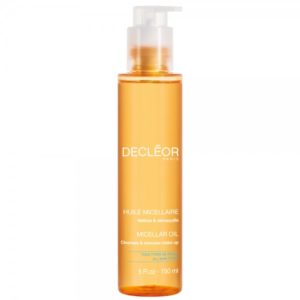You may have noticed a few new additions to our beauty arsenal with the arrival of luxury beauty brand Decleor. Let me tell you, no one has been more excited about our newest brand partner than me. I’ve always loved the brand due to their aromatherapy roots, but thanks to my persistent acne over the years, I’ve stupidly (I’m mentally kicking myself now) shied away from oil based products. 
Now, if you’re an acne sufferer like myself, you know the fear. Oil = grease and grease = spots. Oh how wrong we are. Think about it…healthy skin needs moisture, hydration and nourishment. If you keep using harsh, drying and mattifying products to treat your skin, you’re going to end up in a dehydrated, sensitive skin nightmare. It’s a vicious circle and sometimes it takes a leap of faith to break it.
Enter…Decleor and their new Micellar Oil. As I’ve been banging on about for years, if you don’t crack the cleansing part of your routine, you’re wasting your money on expensive moisturisers as they just won’t be able to do their job properly. Micellar oil contains a unique powerful formulation that stimulates microcirculation and leaves skin deeply cleansed. According to the experts at Decleor, micellar particles work even deeper into the pores, dissolving and dispersing impurities with a specifically formulated complex that gently removes all traces of make-up including waterproof formulas. Once massaged into skin, the fine oil particles kickstart microcirculation to boost radiance leaving the complexion nourished, refreshed and revitalised - perfectly prepped for the next skincare step. To me, that sounds like the perfect cleanser for problem skin, don’t you think?
So I thought, why not? Let’s give it a go.
Now I won’t lie to you (would I ever), when you first change up your skin routine, no matter how incredible the product, your skin will have a bit of a wobbly. Mine certainly did. But I urge you to stick with it as the results are worth it.
I’ve introduced Micellar Oil as my first cleanse at night, and wow does it do its job. Makeup just melts with this stuff and my skin feels so clean and fresh after just one cleanse. It’s also super quick for those of you in a time crunch. I just use 2 pumps and massage into dry skin which starts the process of breaking your makeup down. Then I wet my hands and continue to massage. The oil turns into a more ‘milky’ consistency at this point. Then I just splash my face with cool water to remove. You can also use a damp cleansing cloth if you prefer.
It’s so gentle and effective that I can’t see myself going back. My skin feels nourished and hydrated but at the same time, really clean. Isn’t that what we all want from a cleanser? Plus, it’s helped reduce the sensitivity I was getting on my cheeks. Winner.
Don’t mind me…I’m just off to switch my whole skincare routine over to Decleor.
10/10
xoxo







